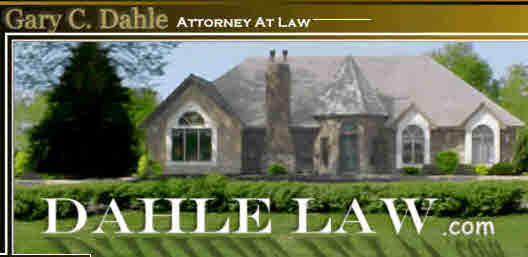19th Century Norwegian Immigration
In the 19th century, Norwegian Lutheran immigrants to the United States could be classified into three groups
(1) Those who sought to continue the traditions and practices of the Norwegian national church as it had existed in their home country, represented by an aristocratic and well-educated clergy, many of whom considered themselves to be of a higher social class than their parishioners (the “Norwegian Synod”);
(2) Those who wanted no part of the Norwegian national church legacy in America, allowing either pastoral or lay person preaching in the local churches, a practice attributed by some in Norway to Hans Nelson Hauge (the “Haugeans”)—although he had directed his followers to retain their membership in the local congregation of the Norwegian National Church; and
(3) Those who saw the value in, and the necessity of, a well-educated clergy, without surrendering control of local churches to either the ordained clergy, or a higher church body (the “Church Reformers”).
In February of 1853 at a meeting held outside of Madison, Wisconsin, a number of ministers of Norwegian and Danish origin—including Claus Lauritz (C.L.) Clausen—organized the Synod of the Norwegian Evangelical Lutheran Church in America, commonly known as the Norwegian Synod.[1]
The Norwegian Synod adopted much of the ritual and customs of the national Church of Norway, and some of the theology of this country’s Lutheran Church Missouri Synod. Its churches were located primarily in Illinois, Iowa, Minnesota and Wisconsin.[2]
In 1868, the Scandinavian Augustana Synod—one branch of the Church Reformers comprised of both Norwegians and Swedes, called August Weenaas, a 33-year-old theological professor from Norway, to serve as the sole Norwegian speaking theological professor at its Augustana Seminary in Paxton, Illinois.[3]
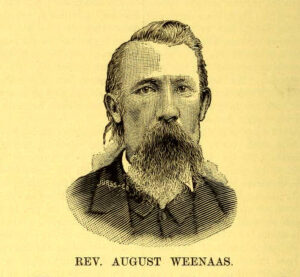
In 1869, certain pastors of Norwegian heritage in the Scandinavian Augustana Synod who desired to have their own seminary for the training of ministers of the gospel, purchased an available school building in Marshall, Wisconsin, to be the site of their new seminary, which was named “Augsburg Seminarium” in October of 1869.[4]
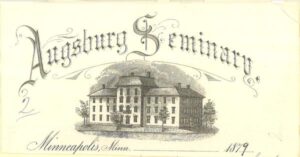
In August of 1870, 14 pastors and 3 lay delegates of Danish and Norwegian descent—including C. L. Clausen—who had resigned from the Norwegian Synod in 1868 primarily due to its refusal to declare human slavery a sin—met at St. Ansgar, Iowa in order to form a new church society composed only of Norwegian speaking Lutheran ministers.[5]
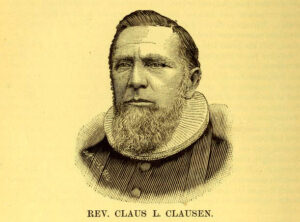
One of the ministers who joined in the formation of the new society was Rev. Ole Paulson, who was then the pastor of Trinity Lutheran Church in Minneapolis, and who would later become one of the primary advocates for the relocation of Augsburg Seminarium to Minneapolis, Minnesota. [6]
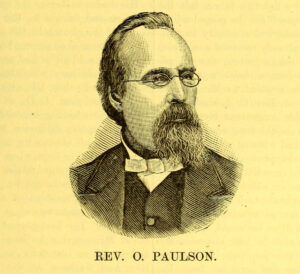
A second minister who joined in the formation of the new society was Melchior Falk (M. F.) Gjertsen, who was then a young pastor in charge of several Scandinavian Augustana Synod congregations in Illinois, and who would later become the pastor of Trinity Lutheran Church in Minneapolis, and a strong supporter of Augsburg Seminary.[7]
Rev. Ole Paulson and M. F. Gjertsen—both of whom attended the St. Ansgar, Iowa organizational meeting in August of 1870—identified that the name adopted by the new society was the Conference of the Norwegian-Danish Evangelical Lutheran Church of America (the “Conference”).
Notes:
The first president of the Conference was C. L. Clausen.[8]
[1] Https://en.wikipedia.org/wiki/Synod of the Norwegian Evangelical Lutheran Church in America, retrieved 10-30-2017.
[2] Https://en.wikipedia.org/wiki/Synod of the Norwegian Evangelical Lutheran Church in America, retrieved 10-30-2017.
[3] Carl H. Chrislock, From Fjord to Freeway (Minneapolis, 1969), page 3, citing August Weenaas, Mindeblade, Eller Otte Aar i Amerika, 1-21 (Volden, 1890); Andreas Helland, Augsburg Seminar Gjenhum Femti Aar, 1869-1919, 25-26 (Minneapolis, 1920). Andreas Helland, Georg Sverdrup, The Man and His Message, 61 (Minneapolis, 1947). Aff. Ole Paulson, March 2, 1897, ¶ 5, page 61. In the District Court of the State of Minnesota in and for the Fourth Judicial District and County of Hennepin, In the Matter of the Application of Nils C. Brun, et al, for leave to file an Information in the nature of Quo Warranto against Sven Oftedal, et al. (Minneapolis, 1897).
[4] Chrislock, From Fjord to Freeway, pages 3-4, citing August Weenaas, Mindeblade, Eller Otte Aar i Amerika, 1-21 (Volden, 1890); Andreas Helland, Augsburg Seminar Gjenhum Femti Aar, 1869-1919, 25-26 (Minneapolis, 1920). Aff. Ole Paulson, March 2, 1897, ¶ 5, page 61.
[5] Minnesota Supreme Court Records and Briefs, 72 Minn. 590, page 23, April 1898; Brief for Appellant – Appellant’s Statement of Facts. Minneapolis Tribune, June 4, 1893, page 5. https://en.wikipedia.org/wiki/Claus_Lauritz_Clausen, retrieved August 15, 2018.
[6] Aff. Ole Paulson, March 2, 1897, ¶ 6, page 62. J. Magnus Rohne; Norwegian American Lutheranism up to 1872, 235 (New York, 1926).
[7] Augsburg Seminary and the Lutheran Free Church, 1928, Affidavit of M.F. Gjertsen, Page 142. Aff. M. F. Gjertsen March 2, 1897, ¶ 3, page 142. In the District Court of the State of Minnesota in and for the Fourth Judicial District and County of Hennepin, In the Matter of the Application of Nils C. Brun, et al, for leave to file an Information in the nature of Quo Warranto against Sven Oftedal, et al. (Minneapolis, 1897). Rohne, Norwegian American Lutheranism up to 1872, 235.
[8] Aff. Ole Paulson, March 2, 1897, ¶ 6, page 62. Aff. M. F. Gjertsen March 2, 1897, ¶ 3, page 142.
Copyright to the text 2019, Gary C. Dahle. All rights reserved.
